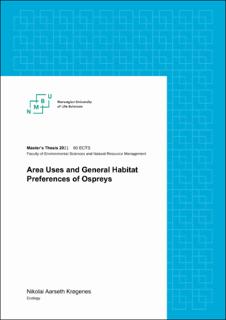| dc.description.abstract | The area uses and general habitat preferences of ten ospreys from south-eastern Norway were studied in their home ranges, wintering areas, and during their migrations. The ospreys were tracked using GPS transmitters and their habitat preferences were analyzed using land cover maps based on satellite imagery. Habitat preferences were defined by the use of different habitat categories compared to the availability, and the distance to the different habitat categories compared to the expectation. Habitat preferences were compared between southward and northward migrations, between adult and juvenile ospreys during southward migrations, and between breeding years and non-breeding years for adults. The ospreys preferred forests in all seasons, they preferred open areas in their home ranges and during migration, and they preferred wetlands in their wintering areas. Water bodies were preferred in the ospreys’ home ranges but were partly avoided during migration and in wintering areas. The ospreys used agricultural areas like the availability in all seasons, and preferred being closer to them in their home ranges and wintering areas. Bare land and urban areas were primarily avoided in all seasons, but some discrepancies were seen. Differences in the ospreys’ habitat preferences were found between northward and southward migrations, possibly due to different migration strategies being used. Differences in habitat preferences between adults and juveniles were found, possibly due to the inexperience of juveniles. And differences were found in area uses and habitat preferences between breeding years and non-breeding years for adults, due to differences in behavior between years. The ospreys used the largest areas in their home ranges with a median size of 87.2 km2 (95% minimum convex polygons). Their wintering areas had a median size of 57.4 km2, and their stopover sites during migration had a median size of 2.5 km2. Kernel core use areas of 50% and 95% were calculated for the different seasons as well, and areas were compared between adults and juveniles. This study has provided a general baseline in the knowledge of ospreys’ area uses and habitat preferences, and the methodology shows promise in being able to study a migrating species’ habitat preferences throughout the seasons using much less resources gathering data. | en_US |

